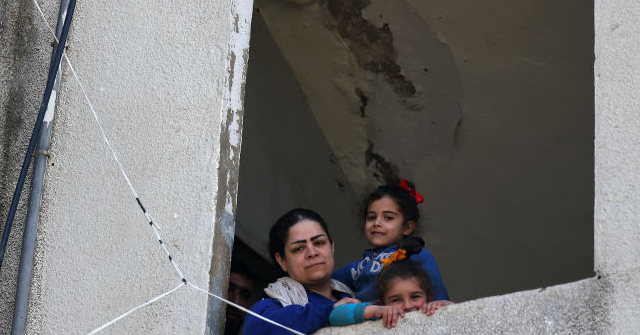A disturbing spree of kidnappings has struck women in the Alawite Muslim minority community in Syria since the fall of dictator Bashar Assad, reports revealed this week, including at least 33 known cases of brazen abductions in broad daylight.
The Alawites are a branch of Shia Islam that comprises about ten percent of the Syrian population, but they were dramatically over-represented in the fallen government of Assad, who was himself an Alawite. A little under 75 percent of Syrians are Sunni Muslims from various ethnic backgrounds.
Many Syrians resented the Alawites for enjoying preferential treatment under the brutal Assad dynasty, which began with Bashar’s father Hafez seizing power in a 1970 coup and ended when a coalition of Islamist rebel groups drove Bashar Assad into exile in December 2024.
Alawite fears that they might face persecution and vengeful violence came true in March 2025, when Alawites were assaulted and killed by jihadi groups that supported the junta in Damascus.
Interim President Ahmed al-Sharaa, a former member of al-Qaeda and the Islamic State, claimed Assad sympathizers sparked the violence by attacking government forces in Latakia, the province where most of Syria’s Alawites live.
Sharaa, eager to convince Western governments he could provide a stable government and protect Syria’s many religious and ethnic groups from factional violence, denounced the wanton massacre of Alawites and had several of the perpetrators arrested. Much of the damage was already done, as terrified Alawites spoke of entire families slaughtered in their homes. Many of the surviving Alawites fled across the border into Lebanon, while jihadi groups threatened similar violence against other targets, including Christians and Druze.
There have been more outbreaks of sectarian violence, although none quite as bad as the March massacre of Alawites, and outside observers fear Sharaa’s government is unable to control some of the jihadi militias that helped overthrow Assad. A horrific gun and suicide bomb attack on a Greek Orthodox church in Damascus last Sunday, blamed on ISIS by the Sharaa government, summoned the specter of ethnic and religious cleansing again.
The mysterious abductions of Alawite women have not received much international media coverage until now, although human rights groups began sounding alarms as far back as April. Victims interviewed in the early stages of the kidnapping spree reported being beaten and tormented by the captors because they were Alawites. Some of the victims were taken to central hideouts where many women were held prisoner at once, handcuffed and chained to chairs.
Syrian human rights advocate Yamen Hussein told Reuters on Friday that the kidnapping spree ramped up after the March attacks and Alawite women are now being abducted in broad daylight almost every day.
Hussein said that only Alawite women have been known to be targeted by the kidnappers, and the identity of the perpetrators remains unknown. There appears to have been little police action against the kidnappers so far.
The stories of kidnap victims related by Reuters were horrifying. Some of the women were allowed to speak with their families to plead for ransom. Few of them have been seen alive again, even after thousands of dollars in ransom money was paid. The kidnappers threatened families into silence by promising further violence if they spoke to government officials or foreign reporters.
“Don’t wait for her. She’s not coming back,” one kidnapper coldly informed the family of 29-year-old Abeer Suleiman after her abduction in May. Suleiman’s family paid $15,000 in ransom to the kidnapper through a mysterious “intermediary,” but she was never seen again.
Impoverished families like Suleiman’s frantically borrowed money from friends and made money transfers through Turkish banks to recover missing wives and daughters, only for the kidnappers to break off communications and disappear after the final transfer was made. Several of the victims mentioned being taken out of Syria in their phone calls to family members.
Most of the abductions have been brute-force attacks in broad daylight, although a few surviving victims report being drugged and spirited off to locations unknown. Some of the victims were teenage girls grabbed on their way to school. Others were women performing simple household errands or using public transportation when they were taken.
Some suspect the missing victims are being sold into slavery, much as the Islamic State did with women kidnapped from Syria’s even smaller Yazidi minority. The perpetrators could be active or former members of the Islamic State, which is trying to make a comeback in Syria and desperately needs funding.
Syrian officials have been cool toward complaints about the kidnapping epidemic, suggesting the Alawites are lying about the abductions to gain sympathy for themselves or to embarrass the post-Assad government, or perhaps that families are concocting lurid kidnapping stories to conceal their embarrassment about runaway wives and daughters.
“Women are either forced into marrying someone they won’t want to marry so they run away, or sometimes they want to draw attention by disappearing,” said Ahmed Mohammed Khair, a media officer for the governor of Tartous province.
The Syria Justice and Accountability Center (SJAC), a human rights organization based in Washington, D.C., demanded action from the Syrian government in May. SJAC said the persecution of Alawites continued after the March massacre despite promises from Damascus, including mob-style executions and the abduction of Alawite women.
“The government must follow through on its responsibilities to citizens to appropriately investigate all violations — including the apparent targeting of Alawites in Homs city — hold perpetrators accountable, and ensure that such killings are not allowed to continue unchecked,” the SJAC said.
Read the full article here


